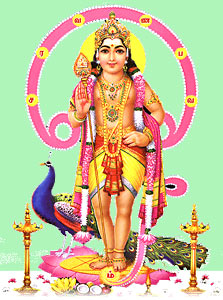Hindu mythology affirms that Kartikeya, also known as Murugan, is the Hindu god of war or the Hindu Mars. Kartikeya is a recognized deity worshipped in Tamil Nadu and parts of south India.
 The birth of Kartikeya has many legendary stories. The Puranas narrates a slight different story of Karthikeya. In the Skanda Purana it is narrated that Shiva first married Sati or Dakshayani, the daughter of Daksha. Daksha never liked Shiva. He did not liked Shiva as he was the lord of destruction and detachment, begged for food, danced in a graveyard smeared with ashes, and has no wealth, not even good clothes for himself. Daksha in public insulted Shiva at a Yajna ceremony. Sati could not take the insult of her husband and immolates herself. The Yajna is destroyed although protected by all the other Gods and the rishis. Sati was reborn as Parvati, daughter Mountain Himavat and later married to lord Shiva.
The birth of Kartikeya has many legendary stories. The Puranas narrates a slight different story of Karthikeya. In the Skanda Purana it is narrated that Shiva first married Sati or Dakshayani, the daughter of Daksha. Daksha never liked Shiva. He did not liked Shiva as he was the lord of destruction and detachment, begged for food, danced in a graveyard smeared with ashes, and has no wealth, not even good clothes for himself. Daksha in public insulted Shiva at a Yajna ceremony. Sati could not take the insult of her husband and immolates herself. The Yajna is destroyed although protected by all the other Gods and the rishis. Sati was reborn as Parvati, daughter Mountain Himavat and later married to lord Shiva.
At this moment, Surapadman, the rakshasa devastated the earth and tortured the people living in the earth. It was realized by the gods that only the son born of Shiva could lead the gods to victory over Surapadman and the demon army. They planned with Kamadeva, the god of love to shoot a flower arrow at Shiva, as he sat in meditation, so that he fell in love with Parvati. As Kamadeva intended to throw his arrow, then suddenly Shiva opened his third eye and was infuriated. At that moment he destroyed Kamadeva with fire and turned him to ashes.
The fire which came out from Shiva was intolerable that Agni, the fire god even could not bear this fire. The fire was then transported by the river Ganga into the Saravana forest into a pool Saravana Poigai. There from the sparks of the fire was born six children. The children were taken care by the six Krittika, the stars that make up the Pleiades. Devi Parvati united the six babies into one with six faces, and named Kartikeya. Kartikeya is also called Kumara, means youth.
Kartikeya became the chief of the other demi-gods then guided the Devas and won the combat with the demons. Kartikeya fought at six places against the asuras and these places are together known as Arupadai Veedu. Arupadai Veedu means six battle fields of the God.
In the Mahabharata Karthikeya is portrayed. Karthikeya is said to have been born from Agni and Svaha. Svaha disguised herself as the sixth of the seven wives of the Saptarishi. The actual wives then become the Pleiades. To kill the Asura Mahisha, Karthikeya was born. Indra attacks Karthikeya because he thinks that Karthikeya is more powerful than him. Lord Shiva interferes and makes Karthikeya the leader of the army of the Devas. Karthikeya was married to Devasena, Indra`s daughter.
The Vedas also relates the story of Karthikeya. In the Atharva Veda Karthikeya is described as `Agnibhuh`, the son of Agni, the fire god. He is also said as the son of Rudra and the ninth form of Agni.
Kartikeya is represented as god mounting on his Vahana, the Peacock and carries the weapon the Vel. He is sometimes depicted with many weapons including, a sword, a spike, a scepter, a discus and a bow although more usually he is depicted wielding a sakti or spear. This signifies Kartikeya`s purification of human ills. His spike symbolizes protection; discus portrays his knowledge of the truth. The mace represents his strength and the bow is a sign of his ability to defeat all ills. His peacock mount symbolizes his destruction of the ego.
The six heads of Kartikeya is represented as the six Siddhis granted upon yogis over the course of their spiritual development.
In prehistoric ages in India, Kartikeya was regarded as the patron deity of thieves. In the Puranas it is said that Kartikeya had dug through the Krauncha Mountain to kill the demon Taraka and his brothers. Kartikeya helped Shiva fight the newborn Ganesha, other son of Shiva. In the Brahma Vaivarta Purana, he is represented as the elder son of Shiva and Ganesha as the younger. In South India, it is believed that he is the younger of the two.
Kartikeya is believed to be a handsome bachelor. Other stories say that he had two wives Valli and Devayani.









